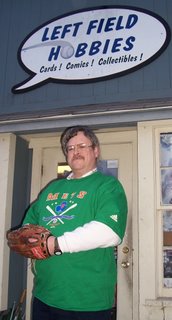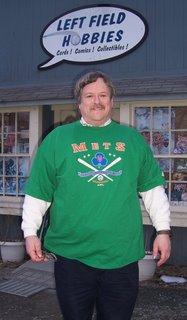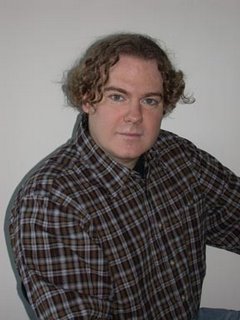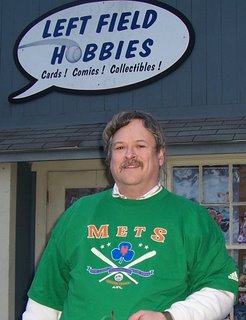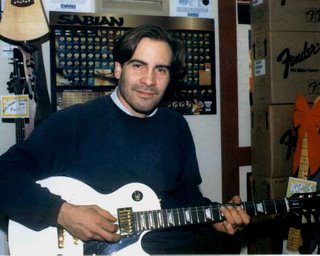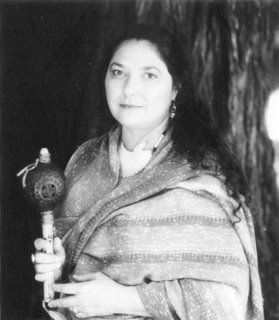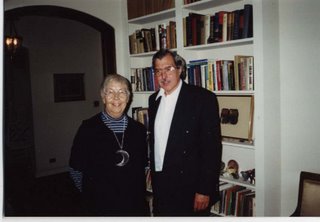IS NOTHING SACRED?
EARTH IN CRISIS
An Interview With
Evan T. PritchardEvan T. Pritchard is of Celtic and Native American descent, raised with the environmentally conscientious Algonquin perspective by his mother and his great aunt Helen Perley—“an outspoken Mi’kmaq activist”—with the love and respect for the Mother Earth that is so common to indigenous cultures. He is the director of the Center for Algonquin Culture based in Woodstock, New York, and is professor of Native American Studies and Philosophy at Marist College in Poughkeepsie, New York. A musician and storyteller, he lectures frequently around the United States and Canada, and is the author of a number of books, including No Word for Time (1998) and the widely read Native New Yorkers (2001).
Earlier this year, British environmental scientist James Lovelock issued a chilling warning about global warming: “We are past the point of no return.” Made famous in the 1970s by his theory of “the biocybernetic universal system tendency,” or “Gaia Theory,” in which the earth (Gaia, from the Greek) regulates itself chemically and atmospherically to promote the ideal conditions for the evolution of life, Lovelock now believes that our negligence and abuse, combined with unforeseen factors, has essentially triggered a sequence of self-destruction that is throwing the system into reverse and will result in the extinction of most forms of life. Lovelock prophesies a future, relatively near at hand, in which spasms of climate change will reduce humanity to “a broken rabble led by brutal warlords,” competing for a dwindling area of habitable space at the planet’s north and south poles. His new book, The Revenge of Gaia, is due to be released by Penguin Putnam in March.
It seemed only natural to begin this interview with Evan Pritchard by asking him what he thought of James Lovelock’s dire prophecy.
Are there any themes in either your book or Native American culture itself that reinforce Lovelock's contention that Gaia—the life-sustaining ”Mother Earth”—is taking her revenge and eliminating us from the planet? Is there anything in your book that would counter it with some measure of hope?
I take his “revenge of Gaia” idea seriously, though I would not put it quite that way. Basically the threshold he is talking of is the same thing as the “crossroads” that are in the Hopi and Algonquin prophecies, and he's saying we've crossed it. I, of course, would like to know why now, not next year or the year after. I foresee a variety of “revenges” that can't all be caused by global warming—for example, earthquakes and tsunamis. We need to use technology to subtract from, not add to the problem. Algonquin culture has very ancient roots here in the New York area, and one key to that longevity has been flexibility and adaptation. But to say it’s too late could contribute to an attitude of resignation, as in: “It’s too late to do anything now anyway.”
One of the main reasons I wrote Native American Stories of the Sacred was to create a deeper mythopoetic background to the idea that Native Americans have tools, ideas, teachings that can help us heal the earth and adapt to changing climates. I hope that this will become the foundation of future work on this subject. The book focuses on the deep environmental teachings that are buried in all world religions by studying the culture that, perhaps more than any other, never left that teaching anywhere but right there for all to see. The multicultural connections in the book help readers to see that teaching everywhere it occurs.
These stories were created at a time when the land and the people were one, but already the elders were seeing the signs as to what happens when people treat Mother Earth with disrespect. There were already prophecies stating that treating the earth poorly would lead to the destruction of mankind, and these stories in the book were intended to help children—as well as adults—find the right balance between what they wanted and what actions should be avoided in order to prevent this terrible destruction. If we had listened to these stories all along, we wouldn’t be in this position today, and if we continue to ignore these kinds of teachings, we will make Lovelock’s predictions come true.
What happens next is up to us. Lovelock says we now can only buy time, but in the ancient stories, the animals and supernatural spirit beings (such as the raven, mouse, rabbit, and coyote) often come to the rescue of the foolish humans at the last minute to bail them out.
It’s hard to predict what will happen, but global warming will cause storms and crop failure, and most certainly lead to pestilence, famine, war, and death, “the four horsemen of the apocalypse,” not to mention disease. The pestilence is already happening, as new types of infestations and infections such as Lyme disease and Ebola virus are spreading, due to environmental causes. Perhaps the pestilence itself will be enough to drive us to rethink our position on the Kyoto Protocol and other worldwide agreements. In this way, it could be said that “animals” came to our rescue. The next is epidemic disease such as bird flu, then famine, then war with, say, China, and other countries that know full well that 25 percent of the carbon dioxide that contributed to the global warming that wiped out their crops came from the United States, which discharges 5.8 billion tons of it into the atmosphere every year.
Thousands of years ago, villages around the world stressed teachings, similar to Native American teachings today, that were designed to prevent the disintegration of the village. As different villages grew, they needed different value systems in order to hold themselves together, developing the shamanistic teachings, the Taoist teaching of The Way, the Buddhist concept of the Dharma, and various expressions of the right way to live, including the Red Road of the Native American. Now that the world is one village, if we forget those ancient values, we will collapse.
There are four or five ways the great cultures of the past have collapsed: through harm to the local environment (Sumeria, Sahara); bad foreign policy (Sumeria, Sung Dynasty, British Empire, Germany); corruption (most of them!); apathy (which usually accompanies corruption); and the mismanagement of economics (too many to name here). The teaching tales of the folk cultures and their altruistic values were in place already to try to prevent this collapse—and they worked. However, for some reason, when cultures reach a dominant position in the world, they start expanding too fast, and they collapse, thanks to these same things.
The stories in my book are full of teachings that helped Native children grow up with good values, to avoid harming the environment, to get along with neighbors, to be honest and fair, to care about life, and to be frugal in trade and consumption. It is my hope, even as climatologists are claiming that we have ruined the entire globe and cannot fix it, that enough people will remember the ancient teachings to find a way to reverse the destruction of the biosphere before it’s too late.
How likely is it that we will be able to turn around climate change and gain some measure of preventive control over the loss of species and the degradation of all forms of life? Will we ever regain some ecological balance? If not, what kind of world do you foresee?
In Lovelock’s worst-case scenario, we have less than a hundred years until there are only small groups camped out at the poles. People are shrugging their shoulders and saying, “We all die eventually.” But this scenario implies a horror of mass extinction that no human has ever witnessed before, not even at Auschwitz, in Rwanda, or anyplace else. Global warming is not a day at the beach. In the worst-case scenario, bugs will go crazy, then animals, then people. Tornadoes and hurricanes will make homes suddenly disappear. Food will become scarce, water will become tainted. People will fight each other, armies will go on the march. When Verrazzano discovered what is now New York City, he saw a terrible storm approaching and set sail on a different course, unintentionally reducing the impact that smallpox, carried unknowingly by his crew, would have. The prophecies, in their most terrible aspects, could indeed come true if we don’t change our course in the face of the storm that is already upon us. This will take some navigational skill.
I think we have just enough time to turn it around, and change the way we live now. I also foresee that even if we miss that mark, great effort will be spent to slow down the process of degradation. I foresee a great Renaissance of human culture worldwide as people realize that they might not be able to accomplish anything in fifty years hence, similar to the inspired writings of a dying man.
I think of New York’s own musical immigrant Gustav Mahler, who wrote Das Lied von der Erde (Song of the Earth) and then the Ninth and Tenth symphonies, only after being diagnosed in 1907 with a fatal heart condition. He moved to New York City to conduct the New York Philharmonic and lived long enough to hear his previous symphonies played, but not the new ones. It makes me wonder if our greatest achievements as humans will only be heard thousands of years later by visitors to this planet as they sort through our remains. I think we can do better!
I support the radical junglification of New York and other cities, and I think that the “green architecture” as developed by John and Nancy Todd, the Native American architectural pioneer Douglas Cardinal, and New York’s own award-winning Makrand Bhoot (the other kind of Indian), will help us avoid this “dying man” scenario. New York should be at the forefront of this amazing movement. In fact, it has already started, with the new Bank of America building near Times Square, which is moderately “green” but on a large scale.
We have the resources, and we know how to make living buildings that do not add to but actually help alleviate pollution. However, we must overcome the technical problems of electric cars, and use even more public transportation than we do now in and around New York. The spirit of the Algonquin Landkeepers is still strong on Manhattan Island; we can find inspiration in them as to how to make this transition, to get ourselves off the dead-end road we’re speeding down and onto the Red Road again, which, as the Hopi say, leads to a world where children will be safe to grow up.
Could you comment on Lovelock's concept of Gaia—the earth as a self-perpetuating living organism—and what it shares in common with Native American philosophy? Also on what Native prophecies portend for the future?
Every Native language has a different way of referring to “Mother Earth.” They all basically mean the same thing. This word “mother” implies that we are little children, that we are from her womb, that we depend on her for our food and for wisdom as to how to live our lives—and that she loves us as a mother loves her children. All these things we attribute to the earth, the planet on which we live. It also implies that she is a living being with thoughts of her own, and a being with which, at certain sacred moments, we can talk, share, and give gifts. We can cry on her shoulder, raise our arms in defense of her, and lament for her unhappiness.
In spite of this wonderful relationship, prophecies of countless tribes and nations foretell the possibility of a day when she can no longer sustain us—that if we do not follow the old teachings, she will make certain adjustments in order to balance herself that will not be to our liking. Some elders say it will be like a dog shaking off so many fleas. The Washo stories of the Water Babies, for example, imply that the forces of nature are not to be taunted or tested, and that the earth has guardians that are so powerful that they can level whole villages with a thought.
We are not the only ones who belong to Mother Earth—there are millions of species, our brothers and sisters, in fact. If we are beating up on our brothers and sisters, we will be sent away from this beautiful home like prodigal sons and daughters. Whether it is wisdom or anger and revenge that causes a loving parent to make this decision is not for me to say, but it is done to protect the rest of the family from harm. The animals, trees, reptiles, fish, and frogs are all family to us, and yet even as they’re being born deformed we don’t change our behavior. Is it so unimaginable that a loving mother such as Gaia would spank us, or even send us out into the cold to die in order to protect the others? In the old stories, it is the other animals who find a way to reach us humans, to convince us to stop and think about what we are doing. We come from a good family. We need to listen to their advice, and it doesn’t get transmitted in words, but in nonverbal ways.
What exactly is “sacred” for the Native American? All life? The whole manifestation? Perhaps the question is, what is not?
In my use of this word “sacred,” I refer to that which is eternal, that which is beyond human improvement, that which should not be changed. I chose stories that were not sacred stories per se—not to be interpreted or changed—but those that referred to the sacred: everyday, fun stories. However, the Algonquin elders say that everywhere you stand is sacred, and every day is sacred—in fact, that all life is sacred. I also believe this, and feel that everything that lives has a place in the sacred hoop of life.
Nature is sacred in a different way—not exactly eternal, not exactly beyond human improvement. Part of our purpose is to interact with nature, to be a part of it, to “comb the mother’s hair” by collecting fallen branches for our hearth fires, to collect acorns, and to keep the deer and beaver population in balance. However, we are not to dig out or remove whole sections of the earth, or destroy any species of local plant or animal. All holes should be refilled eventually—even subway holes, in the long run.
Human life is sacred in a third way. Its sacredness lies in the four gifts that are always changing and growing: our name, which tells us of our mission in life (about which we are always learning more), our free will (which changes its mode of expression every day), our language (which we should be free to use creatively), and our peace of heart and mind (which we must regain every day).
When you speak of the Red Road teachings—or the Native American spiritual philosophy—and equate it with the Mi’kmaq “way of truth,” the Cherokee “way of good,” the Navajo “beauty way,” and in similar spiritual precepts of other cultures, beyond the Native American, what is the thematic thread that you see running through all of them?
The three levels of sacredness I just mentioned can also be found in the descriptions of the Way of the Tao, the Buddhist Dharma, the Hebrew Halakha, the Egyptian Ma’at, the Islamic Shari’a, and others. There is the way of the eternal, in other words, the Way of Heaven. There is the way of Nature, also known as the Pure Land. Thirdly, there is the Way that Humankind Should Live. All three are sacred in different ways. The same can be said of the Red Road.
What role does storytelling play in the Native American spiritual life?
Stories are the essence of mythopoetics, which is the essence of culture. The history of the human race is nothing more than a story told to a child. Stories must have conflicts between characters, good and evil must be addressed in some way—ignorance and knowledge, innocence and experience. Without story, we remember nothing. Jesus, Buddha, Muhammad, all used stories to convey their teachings; it’s how children learn, and adults too. Stories are lessons in 3-D: they present objects and events without direct evaluation, and it is up to us to look at them from all sides, like a sculpture in our minds.
We learn these stories before we have the faculties to reject or censor them, and they become a part of us; they mold our values and opinions. But stories generally do have values to impart, and we have to be careful what we are teaching through them.
Do all Native American stories of the sacred have a moral or practical point to make? Which ones best express the higher concept of the right way to live? What are the major lessons to be learned from these stories?
All the stories have moral and ethical points to make. All are expressions of the Red Road teachings, only many of them are presented in the inverse, which is a very effective teaching tool. For example, one of the best ways to teach about the Ashtangikamarga, or the Eightfold Path as taught by the Buddha, is to teach of the consequences of its opposite. What if we were told a terrible lie about our friend? We would not have right understanding, and would therefore not have right thinking about him. We would then speak badly of him, and then this might lead to actions that weren’t right either. This situation could only be corrected by the Eightfold Path, more carefully followed.
Likewise, the Native American stories often show us the right way (which the Mi’kmaq call Agoolamz) in reverse, in order to show us the chain of unpleasant events that can follow, so that we can make our own decisions and not feel we’re being lectured. There are no eight steps along the Red Road, but there are four directions, corresponding with the four parts of the self—the body, the heart, the mind, and the spirit—all of which want to be in balance. All of these stories, either directly or inversely, teach respect for Mother Earth and for all beings upon it (creatures, plants, rocks), and this definitely includes human beings of all sizes and shapes and colors—including ourselves, with all our flaws.
Would you say that “The earth does not belong to us; we belong to the earth” expresses the essence of the right way to live? If so, could you elaborate on the implications of this statement—the consequences of not living life according to this principle, and the state the earth might be in if we did live according to this principle?
This saying was originally attributed to a certain speech by Chief Seattle. In fact, it has been said for thousands of years by elders across North America, in every language of this land. This is the message behind each of these stories, and it does indeed express the essence of the right way to live on the earth. We have minds and hearts that are connected to the earth, and spirits that live on, somewhere beyond this earth, but our bodies are of the clay and soil of this planet, and we cannot live long without respecting that fact. While we live, if we ignore or think harmful thoughts about our bodies and the connection we have with the earth, we will soon lose our hearts; we will eventually lose our minds; and when that happens, we will lose our souls. It’s that simple.
What we are seeing now is that large numbers of people are afraid to speak up in defense of Mother Earth, and it’s a strange silence. The consequences of not belonging to the earth are that the earth will no longer continue to serve us and help us. Whether this reversal will seem like “revenge” as foreseen by Lovelock in his new book, or whether it will be more of a crippling, a falling away of the beauty of the earth, remains to be seen. Our prayers will show us the way both as individuals and as a race. We can’t rely on mass communication alone to end this silence. We must communicate what we know to our friends and family.
Were the pre-Columbian Amerindian cultures living in a kind of state of grace in which this principle was widely or universally observed? Or was it as little or sporadically observed as it is now? What lesson might be learned from the destruction and subjugation of cultures living the Way by cultures dedicated to an opposing way of life?
I always make a distinction between “traditional” Natives and Native culture as a whole. The old stories are filled with characters such as “The Boy Who Got Mad at the Sun” (also known as “The Boy Who Snared the Sun”), who do not follow the traditional teachings and get into lots of trouble. We laugh at his efforts to snare the sun; meanwhile, we build dams that snare the rivers, make nuclear bombs that snare the atom, and launch ships that snare whales and dolphins. When we finally learn to snare the sun only through solar panels, we’ll have learned a traditional lesson: respect, and proper use of our resources.
Traditional teachings in Native culture about how to leave no traces on the earth are very exact, and, I think, sound a little extreme to those entranced by twenty-first-century culture, but those are the teachings. They’re getting harder and harder to live by in their pure form. I don’t always live up to them, but they’re constantly on my mind. There have always been Native Americans who felt those rules didn’t apply to them, but they are good rules to live by. We all are quasi-traditional to varying degrees, but the traditional teachings don’t change.
The first explorers were often crazy people who weren’t welcomed at home. They were welcomed here, by and large, and wore out that welcome in record time. It is that restless conquering spirit, implanted in the New World at that time, which has led to some of our problems. Enron’s motto, “Get in, get out!” which led to trillions of dollars of damage to the economy, can be traced back to the wild west, and to the conquerors of this land, like Columbus and de Soto. Environmentally speaking, where else are we going to go? The Native culture, which takes things slow, is a good balance to that. Some of those who followed the conquerors were often kind, with good intentions, and it was these salt-of-the-earth working immigrants who often intermarried with the Natives, and whose earth-minded descendants are still here today. They know that “the earth does not belong to us,” and are not the problem, regardless of ethnicity.
What do you see as the force that contributes the most to the loss of life and the decline of wisdom? What can we do to oppose it and turn it around?
As seen in the story “Co-no, The World’s Greatest Gambler,” addiction is probably the most dangerous element that nature has placed inside of us. Addiction gets worse when fed by loowaywoodee, an Algonquin word meaning “bad things in my heart.” We say that poor communication leads to confusion, confusion leads to fear, fear to anger, and anger to violence. These all are loowaywoodee. We also know that, according to “the Way of the Heron,” the Algonquin path of conflict resolution—one of the four paths to wholeness—we can find ways to resolve all conflicts through good communication skills. This will reduce the inner emotional pain that feeds addictions.
We have a lot of inner pain these days, and it leads us into further addictions to materialistic solutions, to entertainment, oil consumption, junk food, alcohol, and drugs. All of these things weaken our connection with the spirit, the true source of wisdom, of which a warm heart and clear mind can only be good servants. Addictions can cut us off from spirit, and can destroy our hearts and minds as well, not to mention the medical problems they cause. The solution is as old as the hills—it’s communication.
We need to meet lies with facts and truth. We need to say that global warming is a fact, and that there isn’t much time, even if Lovelock, Hansen, and Lovejoy and others are wrong. We need to point out that 24 to 26 percent of the carbon dioxide in the atmosphere has its origins in the United States, that everyone but us acknowledges that, and that the underlying cause is an addiction to oil and power. One of the strongest cures for addiction is passionate devotion to something we love. Religion may not always be rational, or even wise, but it’s a powerful cure for self-destructive addictions of all kinds—sometimes a less destructive kind of addiction—and this has been the salvation of millions. If we are as passionately devoted to nature as we are to our addictions, it could really help us break the yoke of addiction to refined oil and all the other unnatural things we crave.
Native American creation stories, like those of other indigenous cultures, and like the Judeo-Christian one, for that matter, are mythical in nature. Although they teach a healthy respect for the environment and for the planet as a living entity, they are not what you would call “scientific.” Are the facts of the geological record, as well as of the evolution of species, taught to Native American schoolchildren today—and accepted as reality by the majority of Native Americans?
I concern myself mostly with preserving what we call the “traditional viewpoint.” However, I come into contact with thousands of Native Americans in the United States and Canada, so I have an idea of prevailing notions that are not traditional. The old stories are meant to pique our interest in subjects, not give us final answers. The “creation stories” are of several types, but all serve to fire up our interest in the origins of all life. Some are “fictional,” as are most of those in my book, and were only told in winter, as entertainment. They were vehicles for important ethical and moral teachings, and occasionally contained zoological facts, such as the fact that birds don’t have marrow in their wing bones (“Deer and Blue Jay”) and that the wren sounds upset before a storm (“Coyote and Wren”). Truly “sacred” stories (and there are a few woven into the book but not featured) are considered to be true by traditional families; however, we of this time have lost the secret of interpreting them. I occasionally come across clues as to how and why they are true, but it’s not my position to explain.
A huge percentage of professional Native Americans today who have advanced degrees are working in environmental or natural science, and that includes the study of evolution. Many feel obligated to be overly careful and exact in their methods of research so as to not be stereotyped as “primitive,” and end up excelling in their field. However, there are gaps in those theories, as there are with the “Bering Strait Theory,” and Natives will be the first to point them out. Schoolteachers and professors are in an especially difficult position, and will stress the areas where story and science agree—for example, the teaching that if we take care of Mother Earth, she will take care of us—the inverse of which is now very easy to see.
You deal at some length with the pervasiveness of gambling in Native cultures, and its metaphysical role as a means of determining and attaining spiritual insight and power. Is there some reason the gambling games that you describe seem to rely almost exclusively on chance—rather than psychological or intellectual skill, like playing poker or other card games involving when to wager and when to pass?
Yes, this struck me as very curious, but logical too. There are many Native American games of skill; for example, bagettaway (lacrosse) has always been a game people gambled on, and card games are popular among Native Americans today too. But yes, there seems to be a preference for games of pure chance. There are three original uses of gambling: as an oracle for foretelling the future, as a way of testing personal power, and for conflict resolution. In each case, the less the intellect can interfere with the process, the purer the result. If both parties in a conflict have equal claim to a property and equal entitlement, or equally convincing sides of a story, a game of chance would determine the winner, like drawing straws, as people still do today. Certainly, an oracle that can be manipulated by the reader is not worth much, and a game of chance that can be manipulated by skill is called “fixed,” and does not show the will of spirit but of deception.
Does the historical role of gambling in Native cultures have a direct (or even indirect) connection to the recent historical development of major profit-making with casinos? Would that metaphysical aspect of gambling still apply in the casino context?
In the book, I take a “two sides of the story” position on this difficult issue. The first side is that gambling has always been an important and even healthy part of Native American culture, and that it was used for sacred purposes. (I devote a whole chapter to this: “Wager for the World.”) The second side is that gambling, especially when taken out of a sacred context, can become highly addictive and destructive to society, as described in horrible detail in the story “Co-no, The World’s Greatest Gambler.” Some Native Americans go to these new casinos, which are all computer-driven and -controlled, hoping to gain that metaphysical experience of tilting the odds with their presence, but I don’t think it’s possible, and I think there is a danger of falling into gambling addiction anyway.
I support traditional gambling, especially as it was used in the old days, for conflict resolution; as an oracle; and to test one’s intuitive powers; and I prefer that to computer-driven casinos, some of which are better run than others. New York State has aggressively pursued Native American involvement in the building of casinos in the past ten or so years, and gains control over the tribal councils this way, and also raises money for the state budget by keeping most of the money. The upshot is, “Don’t blame Native Americans if you don’t like government-run casinos!” And I would hope that more of that money would go towards making New York City—and the world—carbon-neutral and pollution-free.
Evan T. Pritchard’s Web site:
www.algonquinculture.org
Open House, at the New York Open Center
May 12th, 8pm, Introduction to:
Four Paths to Wholeness in Algonquin Culture,
Thursday, May 25
The Path of the Shaman
Thursday, June 1
The Way of the Heron
Thursday, June 8
The Path of the Heart
Thursday, June 15
The Way of the Ethical Warrior
7:45 – 9:30pm
$80 for members; $85 for nonmembers
$22 per session
New York Open Center
83 Spring Street
212-219-2527
info@opencenter.org

